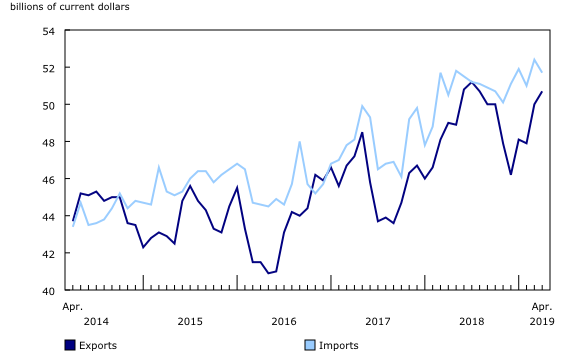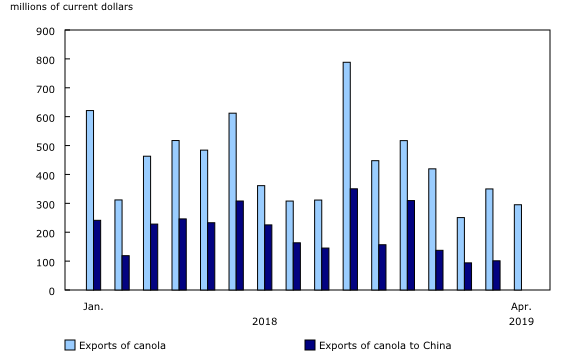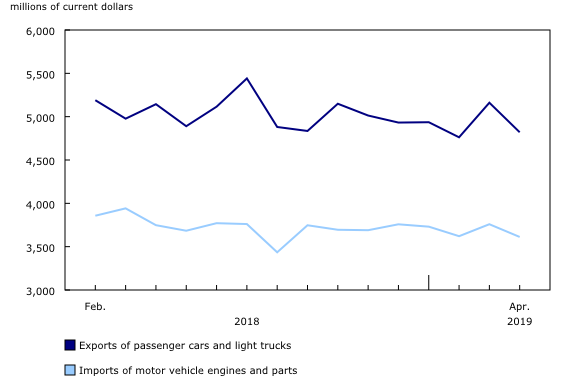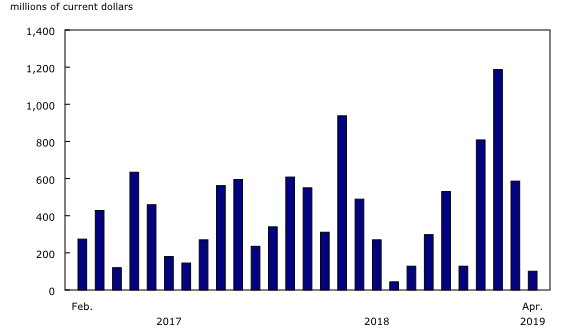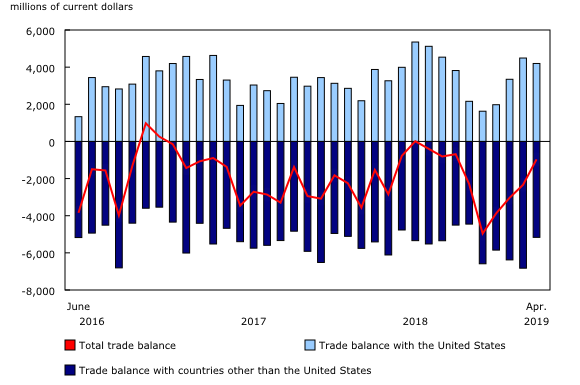Canadian international merchandise trade, April 2019
Archived Content
Information identified as archived is provided for reference, research or recordkeeping purposes. It is not subject to the Government of Canada Web Standards and has not been altered or updated since it was archived. Please "contact us" to request a format other than those available.
Released: 2019-06-06
Canada's exports rose 1.3% in April, due mainly to higher exports of gold. Imports decreased 1.4%, mostly on lower imports of aircraft. As a result, Canada's merchandise trade deficit with the world narrowed from $2.3 billion in March to $966 million in April, the lowest deficit since October 2018.
In real (or volume) terms, exports were up 2.0% and imports fell 1.9%.
Strong increase in exports of gold
Following a 4.4% gain in March, total exports were up 1.3% to $50.7 billion in April, with 6 of 11 product sections posting increases. Higher exports of metal and non-metallic mineral products were partially offset by lower exports of motor vehicles and parts. Excluding energy products, exports rose 1.8%.
Exports of metal and non-metallic mineral products were up 15.0% in April to $5.7 billion. Increased purchases of gold within the banking sector in April contributed to higher Canadian exports to Hong Kong and the United Kingdom. This coincides with a recent increase in global demand for gold.
Exports of farm, fishing and intermediate food products (+5.1%) also contributed to the increase, mainly on higher exports of wheat (+21.7%). The increase was partially offset by lower exports of canola (-14.7%), for which there were no shipments to China in April. For the year 2018, 47.5% of Canadian exports of canola were destined for that country.
Partially offsetting the overall increase in April were lower exports of motor vehicles and parts (-4.6%), mostly on decreased exports of passenger cars and light trucks. There were atypical shutdowns in April at some Canadian assembly plants, which led to a decrease in imports of engines and parts (-3.9%), as well as to a decline in light vehicle exports (-6.6%).
Despite a modest decrease in exports of energy products (-0.5%) in April, there were large fluctuations in some categories within this section. Exports of crude oil rose 11.7% in April to $7.8 billion, on higher volumes and higher prices. This increase was largely offset by a decrease in exports of natural gas (-45.3%), mainly due to lower prices. This follows harsh weather conditions in the United States, as well as supply constraints that contributed to a 31.8% rise in natural gas prices from January to March.
Lower imports of aircraft
Total imports were down 1.4% in April to $51.7 billion. Imports decreased in 6 of 11 sections, with aircraft and other transportation equipment and parts contributing the most to the decline.
After decreasing 15.6% in March, imports of aircraft and other transportation equipment and parts declined 23.6% in April to $1.9 billion. Following a record $1.2 billion in February, imports of aircraft were down sharply in March (-50.7%) and continued to decline in April (-82.7%), mainly due to lower deliveries of airliners from the United States.
Following a record high in March, imports of consumer goods declined 3.0% in April to $10.6 billion. Imports of pharmaceutical products, which reached a record high in the first quarter of 2019, led the decline in April, down 7.8% to $1.7 billion, mainly on lower imports from Europe.
Partially offsetting the overall decrease, imports of energy products rose 10.7% to $3.5 billion, the third consecutive monthly increase. Higher imports of refined petroleum products (+13.9%) led the gain in April, in part due to increased imports of motor gasoline from the Netherlands. Crude oil imports (+7.9%) were also up, on higher volumes.
Trade deficit with non-US countries narrows
After rising 7.8% in March, imports from countries other than the United States fell 7.0% in April to $18.1 billion. Lower imports from China (various products) and Saudi Arabia (crude oil) contributed the most to the widespread decrease.
Exports to countries other than the United States increased 2.4% to $12.9 billion in April, mainly on higher exports to Hong Kong (gold). Gains were also observed in exports destined for China (copper), Norway (nickel) and Indonesia (wheat).
As a result, Canada's trade deficit with countries other than the United States narrowed from a record $6.8 billion in March to $5.2 billion in April.
Imports from the United States were up 1.9% to $33.6 billion in April, while exports increased 0.9% to $37.8 billion. As a result, Canada's trade surplus with the United States narrowed from $4.5 billion in March to $4.2 billion in April.
Revisions to March exports and imports
Revisions reflect initial estimates being updated with or replaced by administrative and survey data as they become available, as well as amendments made for late documentation of high-value transactions. Exports in March, originally reported as $49.0 billion in the last release, were revised to $50.0 billion, mainly on revised exports of crude oil (+$772 million). Given the late reporting of crude oil transactions, statistics on these exports must be estimated in the current month's release, and can be subject to large revisions during times of high volatility in energy prices.
March imports, originally reported as $52.3 billion in the last release, were revised to $52.4 billion in the current month's release.
Notice to users of the Canadian International Merchandise Trade Database
Please note that for the release of June 6, 2019, the Canadian International Merchandise Trade Database will not be available with data from the latest reference period at 8:30 a.m. Due to technical issues, the entire database will be off-line starting at 8:30 a.m. and will be available again once the new data have been loaded. We expect this process to take approximately three hours. We apologize for the inconvenience.
Note to readers
Merchandise trade is one component of Canada's international balance of payments (BOP), which also includes trade in services, investment income, current transfers and capital and financial flows.
International trade data by commodity are available on both a BOP and a customs basis. International trade data by country are available on a customs basis for all countries and on a BOP basis for Canada's 27 principal trading partners (PTPs). The list of PTPs is based on their annual share of total merchandise trade—imports and exports—with Canada in 2012. BOP data are derived from customs data by making adjustments for factors such as valuation, coverage, timing and residency. These adjustments are made to conform to the concepts and definitions of the Canadian System of National Accounts.
For a conceptual analysis of BOP versus customs-based data, see "Balance of Payments trade in goods at Statistics Canada: Expanding geographic detail to 27 principal trading partners."
For more information on these and other macroeconomic concepts, see the Methodological Guide: Canadian System of Macroeconomic Accounts (13-607-X) and the User Guide: Canadian System of Macroeconomic Accounts (13-606-G).
Data in this release are on a BOP basis and are seasonally adjusted. Unless otherwise stated, values are expressed in nominal terms, or current dollars. References to prices are based on aggregate Paasche (current-weighted) price indexes (2012=100). Volumes, or constant dollars, are calculated using the Laspeyres formula (2012=100).
For information on seasonal adjustment, see "Seasonally adjusted data – Frequently asked questions."
Revisions
In general, merchandise trade data are revised on an ongoing basis for each month of the current year. Current-year revisions are reflected in both the customs and BOP-based data.
The previous year's customs-based data are revised with the release of the January and February reference months, and then on a quarterly basis. The previous two years of customs-based data are revised annually and revisions are released in February with the December reference month.
The previous year's BOP-based data are revised with the release of the January, February, March and April reference months. To remain consistent with the Canadian System of Macroeconomic Accounts, revisions to BOP-based data for previous years are released annually in December with the October reference month.
Factors influencing revisions include the late receipt of import and export documentation, incorrect information on customs forms, replacement of estimates produced for the energy section with actual figures, changes in classification of merchandise based on more current information, and changes to seasonal adjustment factors.
For information on data revisions for crude oil and natural gas, see "Revisions to trade data for crude oil and natural gas."
Revised data are available in the appropriate tables.
Real-time data table
Real-time table 12-10-0120-01 will be updated on June 17.
Upcoming release of trade data by industry
On July 3, 2019, Statistics Canada will be releasing a new table featuring Canadian international merchandise trade data by industry for all countries. The trade data published in table 12-10-0136-01 are created using the concordance of the Harmonized Commodity Description and Coding System (HS) codes to the 2017 North American Industry Classification System (NAICS) version 2.0. Data are available for detailed NAICS codes from Manufacturing industries (31-33), Agriculture, Forestry, Fishing and Hunting industries (11), Mining, Quarrying, and Oil and Gas Extraction industries (21), Utilities (22) and Wholesale Trade industries (41). Data in table 12-10-0136-01 are monthly and on a customs basis.
Next release
Data on Canadian international merchandise trade for May will be released on July 3.
Products
Customs based data are now available in the Canadian International Merchandise Trade Database (65F0013X).
The updated Canada and the World Statistics Hub (13-609-X) is available online. This product illustrates the nature and extent of Canada's economic and financial relationship with the world using interactive graphs and tables. This product provides easy access to information on trade, investment, employment and travel between Canada and a number of countries, including the United States, the United Kingdom, Mexico, China, Japan, Belgium, Italy, the Netherlands, Spain and many others.
Contact information
For more information, contact us (toll-free 1-800-263-1136; 514-283-8300; STATCAN.infostats-infostats.STATCAN@canada.ca).
To enquire about the concepts, methods or data quality of this release, contact Benoît Carrière (613-415-5305; benoit.carriere@canada.ca), International Accounts and Trade Division.
- Date modified:




